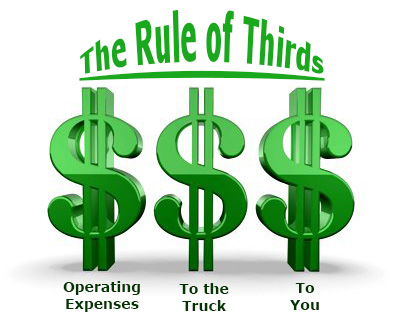The Rule of Thirds lets you know.
The Rule of Thirds is a concept that tells you where your gross revenue should be divided up and distributed. It is akin to a budget but is more generalized. It is a barometer of your money.
Basically, one third of your gross revenue will go to operating expenses (chiefly fuel, oil, fuel additives, truck washes, tolls, parking and other costs to operate the daily business), one third goes to the truck (maintenance, repair, insurance, registration), and one third goes to the driver. If any of these thirds are significantly out of whack, there’s a problem, and it tells you where to look in order to fix it, as well as how to help in preventing it from happening in the first place.
It’s not a hard and fast rule, of course, but a general one. There will be times when the percentages vary greatly from the 33 percent. Unfortunately, most of those times will be when it is your Third that takes the biggest hit. If you operate knowing the Rule of Thirds, and plan accordingly, you can weather most problems. If you spend 25% on fuel and oil, another 20% on the truck, and then pocket & spend the other 55%, it’s a problem waiting to happen, because you don’t have any money available for maintenance and repair. On the other hand, if you buy less expensive parts online instead of paying list price at a dealer, and if you can do some or most of the maintenance yourself, you can take those savings and add that to your personal third.
Most people will put 12,000 to 15,000 miles a year on their car. They are familiar with the maintenance schedules for that kind of mileage. Every 2 or 3 years you have to do this, and every 4 or 5 years you have to do that. Most come into expediting with that mindset. But in expediting, you are putting five years’ worth of miles on your truck every year. You have to plan for that.
One important part of planning for your expenses is to know your Cost Per Mile (CPM). You need to know how much it costs you for every mile you move your truck, loaded or not, paid or not. Some people, newbies especially, will look at a high paying load, like a $1000 load, and they will subtract whatever their fuel will cost to run that load, and think whatever is left over is what they are making on the load. Say you’re in a Sprinter getting 20 MPG and the load is 900 miles that pays $1000. 900 miles divided by 20 MPG is 45 gallons of fuel, at $4.00 a gallon is $180, so you think you’ve cleared $820. If you are one who dismisses the CPM as irrelevant, and think deadhead doesn’t matter, that’s it’s only the revenue of the next load that matters, then you won’t consider the 150 mile deadhead to go pick up the load as important. Even if you figure in the cost of fuel for the deadhead, which is about $30 in this case, you’ll think you’re clearing $780 for the load.
But the Rule of Thirds should tell you that one third of that $1000 goes for operating expenses, another third goes to the truck, and the remaining third goes to you. So, you actually make about $333 on the load, not $780. And if you take that $780 and pocket or spend it, it’s a problem waiting to happen down the line.
Granted, 20 MPH is pretty good, better than most vehicles, so the One Third for operating expenses is actually lower, and thus the One Third to you is higher. But the One Third to the truck still has to go to the truck and it should be set aside and not touched until the truck needs it.
The Rule of Thirds apply to every vehicle in trucking, be it a cargo van, Sprinter, straight truck or a big truck. Adjustments are made to the percentages based on rate of pay, individual vehicles, how maintenance is performed, and on how well you can minimize operating and maintenance expenses. But it is a rule that gives you a good basis with which to make decisions, and as a tool to help you identify where your money is going but shouldn’t be.
